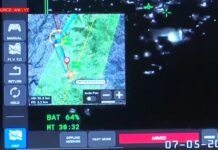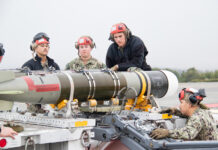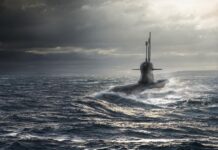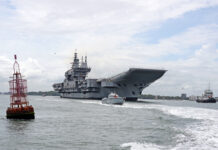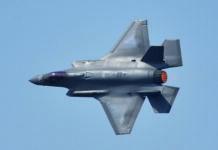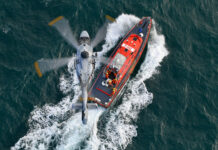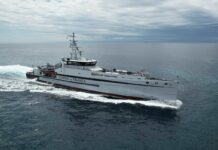In the naval domain, both fixed and rotary wing types perform a wide range of missions.
These range from fast-jets flying from aircraft carriers for air-to-air and air-to-surface sorties to helicopters being used for:
- anti-submarine warfare (ASW)
- anti-surface warfare (ASuW)
- Search and Rescue (SAR)
- Airborne Early Warning (AEW)
- General logistics
One of the most prolific users of manned naval aircraft is the United States Navy and its NIMITZ class aircraft carriers. Their air-wing of up to 100 aircraft is broken down into:
- four squadrons of fast jets
- two helicopter squadrons (stationed on both the carrier and its escorts)
- a squadron each for AEW and Electronic Warfare (EW) squadron
- a detachment of Carrier On Board Delivery (COD) aircraft
American Naval Air Power
The backbone of these air wings is the combat aircraft component, with the four squadrons currently made up of F/A-18C HORNETs, F/A-18E/F SUPER HORNETS and F-35C LIGHTNING IIs. These are drawn from both the US Navy and Marine Corps with the F-35C currently replacing the F/A-18C. Between them, these aircraft carry out the full spectrum of air-to-air, air-to-ground, counter-shipping, reconnaissance, and buddy refuelling missions.
The introduction of the F-35C is now bringing the aircraft carriers fifth-generation combat capabilities such as fused sensors and low observable technology. The combat squadrons are supported by a squadron (consisting of around five) EA-18G GROWLER aircraft. This derivative of the SUPER HORNET is specially equipped for EW with jamming pods and anti-radiation missiles. This force will be recapitalised with the introduction of the Next Generation Jammer in the years ahead. The four combat squadrons provide the carrier’s offensive power and protect it from threats as part of a layered system. This consists of the ship’s own defensive weapons, surface escorts and the combat aircraft which are directed by the E-2C HAWKEYE AEW aircraft. This is a design dating back to the early 1960s but is now being rejuvenated through the introduction of the E-2D ADVANCED HAWKEYE. Entering service since 2019, this new variant features digital flight and mission controls in addition to inflight refuelling and cooperative engagement capabilities.
Another key component of the strike group is the rotary wing element. This has now been standardised on the latest generations of maritime variant of the BLACKHAWK family (which has been extensively exported). The first facet of this comes in the form of the MH-60 ROMEO which is fitted with a radar and ASW sensors to conduct this mission. The helicopter can also perform ASuW missions using the HELLFIRE missile to target Fast Inshore Attack Craft (FIAC). It is also able to perform roles including utility transport, SAR and supporting naval gunfire missions. Accompanying the MH-60R is the SIERRA version, which is deployed in the Combat Search and Rescue (CSAR) mission and Mine Countermeasures (MCM).
Finally, each carrier embarks a GREYHOUND COD aircraft (using the HAWKEYE airframe but without AEW equipment) for the essential role of supplying the battle group with everything from food to letters from home. This veteran aircraft is in the process of being replaced by a US Navy specific variant of the V-22 OSPREY tilt-rotor. Currently being inducted, this aircraft has the added advantage of being able to deliver supplies to accompanying ships directly by virtue of its ability to hover.
The UK
Another significant operator of naval aircraft is the UK, which last year deployed 18 F-35B Short-Take-Off-Vertical-Landing (STOVL) fighters (from both the RAF and USMC) around the world aboard HMS QUEEN ELIZABETH. Alongside the F-35B during this long-awaited deployment were a wide array of naval aircraft. One of the most prominent was the Leonardo MERLIN in both HM2 and HC4 variants. The former carried out the ASW role from the aircraft carrier itself while some carried an AEW radar. The HC4 meanwhile are utility examples transferred from the RAF and put through a navalisation process where they were fitted with features including a folding tail rotor for shipboard operations. The HC4s were based aboard the auxiliary vessel RFA FORT VICTORIA and carried out numerous roles including logistics and the deployment of Royal Marine Commandos in the ‘Joint Personnel Recovery’ role of rescuing downed aircrew.
The other naval aircraft employed during this deployment was the AW159 WILDCAT helicopter. Based onboard accompanying frigates and destroyers, these aircraft were employed in the ASuW role, alongside various utility tasks. These helicopters marked their maturity during the voyage by test firing the MARTLET Lightweight Multirole Missile, which is designed to neutralise FIACs, for the first time. The MERLIN and WILDCAT form a key part of the UK’s naval aircraft portfolio, with both having enjoyed some export success. The WILDCAT has been purchased by South Korea and the Philippines while examples of the MERLIN are currently being manufactured for Poland.
EU Navies
While the UK is basking in the glory of the deployment of its two new carriers, these remain conventionally powered. The only state outside of the US to successfully field a nuclear-powered aircraft carrier to date is France. The 40,000 ton CHARLES DE GAULLE is able to routinely deploy around 30 Dassault RAFALE multi-role aircraft. These are supported, in a fashion similar to the US Navy, by three E-2C HAWKEYE AEW aircraft (a contract has been signed for these to be replaced by the E-2D variant). Also integrated with the aircraft carrier is a wide range of helicopters including the NH-90 NATO Frigate Helicopter (NFH) variant, which is equipped with an advanced radar for surface searches in addition to a dipping sonar and sonobuoy dispenser for ASW. These aircraft (which are operated by several other European nations including Germany) are deployed around the French fleet on ASW tasking. Later this decade, the French Navy will be taking delivery of a marinised variant of the H160M for tasks including ASuW (with the Anglo-French SEA VENOM missile), maritime security and SAR. This is a joint programme with the French Army and Air Force, which intends to replace several different helicopter models with a common type.
Several other European nations rely on naval aircraft and one of the most notable is Italy. This is a country currently in the process of making more aircraft deployable at sea through NH-90 NFHs operating from several classes of surface combatant including the THAON DI REVEL class of modular Offshore Patrol Vessels. The Italian Navy has also taken advantage of the V/STOL capabilities offered of the F-35B by ordering it (for use in a joint fleet with the Italian Air Force) to replace the legacy AV-8B HARRIER II. These have been trialed during a deployment to the East Coast of the US on the aircraft carrier CAVOUR, which also carries AW101s for ASW, ASuW and AEW. Italy is currently inducting the new Landing Helicopter Assault TRIESTE, which will also be able to deploy these types.
A similar type of vessel is fielded by Spain. The JUAN CARLOS is a multi-role vessel that has a flight deck and well-dock. From it, Spain operates a small fleet of EAV-8B+ HARRIER IIs for air defence, ground attack and reconnaissance in addition to a wide range of helicopters. These include the SH-60F SEAHAWK for ASW and utility transport alongside the AB 212 (also utilised in the latter role). The ship is also compatible with Spanish Army aircraft such as the CH-47 CHINOOK and the NH-90, which the Spanish Navy also intends to operate in the ASW and ASuW roles. The design of the JUAN CARLOS has been exported as the basis of the ANADOLU class being procured by the Turkish Navy.
Turkish Plans
This force is traditionally focused on rotary wing naval aircraft, in this case the SH-60 SEAHAWK for ASW from frigates, in addition to various land based maritime patrol aircraft. However, Turkey will soon be operating the SEAHAWK from the ANADOLU class, one of which is being built with a second planned. The country had originally planned to join others in deploying the F-35B from these vessels. However, in 2019, Turkey was removed from the F-35 programme when it decided to purchase the S-400 SAM system from Russia. Turkey may yet be able to deploy fixed wing manned naval aircraft because there are proposals to launch the Turkish Aerospace Industries HURJET instead. This is an indigenously developed single engine trainer aircraft that could launch from the ship’s ski-jump and perform limited reconnaissance and ground attack missions before being recovered using an arrestor wire.
Russia
Turkey inhabits a particularly volatile region at a crossroads between the Middle East and the Black Sea, where the naval element of Russia’s war against Ukraine is playing out. The mainstay of Russia’s fleet of naval aircraft is Kamov’s family of distinctive co-axial helicopters. The Ka-27 is the variant used for ASW whereas the Ka-29 can be used to transport naval infantry from ship-to-shore. A third model is the Ka-31, which has a rotating radar array beneath the fuselage to provide an AEW capability. Most of these are deployed from destroyers, frigates and corvettes as Russia only has one aircraft carrier, the ageing ADMIRAL KUZNETSOV. The carrier, which uses a ski-ramp to launch and arrestor wires to recover aircraft, now has a multi-role capability. This comes through the Mig-29K FULCRUM, a marinised version of this medium sized twin engine fighter aircraft. The aircraft saw its operational debut in late 2016 when the ADMIRAL KUZNETSOV was deployed in the Eastern Mediterranean to conduct operations against anti-Assad regime forces in Syria. Here, the aircraft used both guided and unguided munitions to prosecute a range of targets.
Eastern Rivalries
While Russia has had limited success modernising its naval aircraft, this is not true of its ally China. As the People’s Liberation Army Navy (PLAN) moves from a force focused on defending its immediate coastline to one that has global power projection capabilities, a centerpiece of this is naval aircraft and the carriers they operate from. In 1998, China purchased an aircraft carrier that had been built in Ukraine for the Soviet Navy. The PLAN christened this vessel LIAONING and refurbished it for use in training crews in the operation of aircraft carriers. The ship, which displaces up to 66,000 tons, reportedly has an air-wing of 24 fighters. These are the J-15 FLYING SHARK, a derivative of Russia’s FLANKER family, which is launched using a ski jump but recovered using arrestor wires.
The LIAONING has since been followed into service by the SHANDONG, a larger vessel displacing up to 70,000 tons and carrying as many as 36 J-15s. China is currently building what is termed the ‘Type 003’ carrier, which will use catapults and arrestor wires similar those utilised on American vessels. In terms of naval aircraft to be carried, this would unlock a whole new range of options. In addition to a J-15 modified for launch from this vessel, the PLAN reportedly aims to deploy stealthy fifth-generation aircraft from this carrier. This could be either a navalised variant of the J-20 (the land-based version of which if broadly equivalent to the US Air Force’s F-22 RAPTOR) or the a similarly adapted version of the FC-31. This is a smaller stealth aircraft designed for export and is similar in size to the F/A-18E/F SUPER HORNET, DASSAULT RAFALE, Mig-29k and F-35, the latter which it closely resembles. Crucially, this launch and recovery arrangement will enable the deployment of an AEW aircraft to improve situational awareness. Accordingly, China is said to be developing the KJ-600, a propellor powered AEW aircraft resembling the E-2D HAWKEYE. Until now, the PLAN has relied on the Ka-31 and other types (including licence built versions of European aircraft) for AEW and other support roles including ASW.
India’s Modernisation
A regional rival of China and a long-term operator of naval aircraft is India. The sub-continent has been operating aircraft carriers since the early 1960s having purchased decommissioned British vessels. It broke with this trend in 2014, however, with the induction a refurbished KIEV class carrier renamed VIKRAMADITIYA. This is equipped with several examples of the MiG 29k and is supported across the naval air arm with other aircraft of British, French, Indian and Russian origin. This diverse mix of aircraft will soon become more eclectic as deliveries of the MH-60R begin. Following the VIKRAMADITIYA, India will bring two indigenous aircraft carriers into service. Called the VIKRANT class, the first, named INS VIKRANT will have a ski-ramp and arrested recovery configuration while the second, INS VISHAL, will use the catapult and wire method. India is currently considering various indigenous and overseas aircraft to operate from these alongside the Mig-29k.
As the threat from China has grown, other countries in the region, which have traditionally only operated naval aircraft from land (historically the P-3 ORION family), are now looking to deploy more of them from the sea. Under its post-World War Two constitution, Japan has been prohibited from deploying offensive weapons such as aircraft carriers. However, in October 2021, the USMC landed one of its F-35Bs on the JS IZUMO, Japan’s largest warship. The country has also placed an order for this variant of the aircraft, notionally to deploy from un-prepared airstrips in the region, however, most analysts believe this is a prelude to re-establishing an aircraft carrier capability.
Conclusion
As the world becomes more unstable in light of the war in Ukraine, which itself has forced countries to reassess their priorities, one certain remains. Manned naval aircraft are in high demand for use across a wide range of roles and they are set to evolve with threats to international naval forces.
Jack Richardson





![New developments in multirole helicopters French helicopters operating in Mali. Shown here are the Tiger (Top), H225M (background left), and NH90 (foreground, right). [Airbus]](https://euro-sd.com/wp-content/uploads/2025/09/French-NH90H225MTiger-in-Mali-Copyright-Airbus-Kopie-218x150.jpg)
